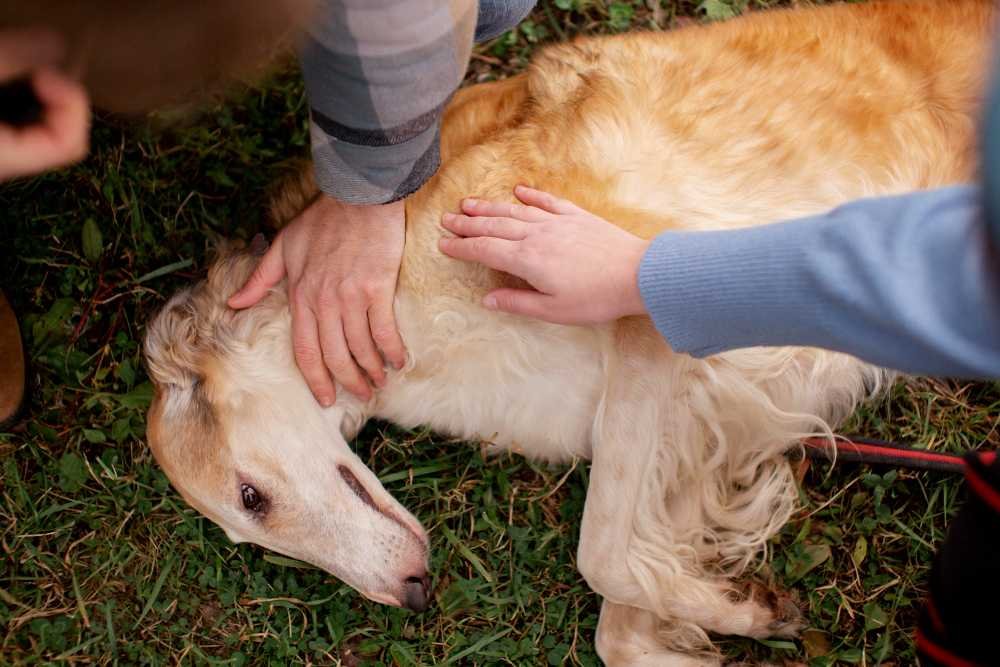Experiencing a seizure can be alarming for all those involved, as it always indicates an underlying and severe issue. When their cherished pet begins to seize, owners may often experience a profound sense of helplessness.
Dog owners have to understand the subsequent actions required to assist them in supporting their dogs during seizures. Although witnessing a seizure can be distressing, owners must remain calm and promptly contact their veterinarian. Here’s the essential information you should be aware of.
What are Dog Seizures?
Seizures are neurological conditions in dogs, occurring with high frequency. They are also referred to as convulsions or fits. This condition is characterized by temporary disruptions in normal brain function, often accompanied by uncontrollable muscle movements.
Epilepsy is the term used to describe recurring episodes of seizures. In cases of epilepsy, attacks can either happen individually or in clusters. Their occurrence can be sporadic and unpredictable or follow regular intervals.
Seizures are generally less traumatic for the animals themselves. Typically, dog seizures characterized by muscle spasms and involuntary movements range from a few seconds to a few minutes.
Types of Dog Seizures
Occasionally, what may appear as a seizure could be entirely different. Confusing muscle tremors with seizures in dogs can be misleading since they all result in involuntary muscle movements.
Seizures can manifest as any abnormal involuntary behavior and come in various types.
Generalized Seizures
When a dog’s brain experiences abnormal electrical activity that affects most of its regions, it results in generalized seizures. These seizures are commonly associated with the typical image people have in mind when they think of episodes.
When experiencing this type of seizure, the entirety of the dog’s body experiences stiffness and may go through cycles of contraction and stiffness. The animal becomes unconscious, and involuntary urination or defecation is possible.
Generalized seizures can be categorized into three distinct phases:
Pre-Seizure Phase: Before an attack, it is commonly observed that many dogs go through a phase known as the pre-seizure phase. Similar to individuals to experience seizures, dogs may encounter unusual visual or sensory perceptions in the moments leading up to the attack. During this phase, dogs exhibit the following:
- Restlessness
- Display atypical behaviors
- Appear to gaze absently into the distance.
Actual Seizure: This is the solid seizure phase. At this stage, dogs become entirely unaware of their surroundings. They also collapse, and their bodies become rigid.
Post-Seizure Phase: Following the conclusion of a seizure, dogs experience a post-seizure phase characterized by potential dullness, restlessness, lethargy, temporary blindness, and instability while walking.
Partial Seizures
As opposed to generalized seizures, partial seizures manifest as atypical electrical activity in specific brain regions, when dogs undergo partial seizures, they typically display distinctive movements confined to a particular body area.
What Causes Dog Seizures?
Seizures in dogs are characterized by disrupted electrical activity in the brain, resulting in a loss of bodily control. Regardless of the specific cause, various factors can trigger seizures in dogs, including:
- Head injuries
- Toxin-related illnesses like xylitol toxicity
- Diabetes
- Tumors- insulin-secreting tumors
- Epilepsy
- Heartworms
- Heat exhaustion
- Liver disease
- Ingestion of poisons like caffeine
- Infectious diseases
- Nutritional imbalances.
Old Dog Seizures
Seizures can occur in dogs of any age and can be attributed to various factors. In senior dogs, the occurrence of an appropriation for the first time is frequently associated with potential structural issues in the brain, such as a stroke or tumor.
While the above causes are commonly observed, it is essential to note that there are exceptions to this pattern. In some instances, the precise cause of senior dog seizures remains unknown, leading to a diagnosis of idiopathic epilepsy.
Even if a tumor or a stroke is identified, treatment options are often available to enhance your old dog’s quality of life. This also helps to provide them with comfort during their remaining time.
Dog Seizures Treatment
The treatment protocols for seizures vary depending on their underlying cause. If a dog has an underlying condition like kidney disease, cancer, or any metabolic disorder, addressing and treating that specific disorder can help lower the likelihood of future seizures.
In cases where no underlying cause is identified, and the dog is diagnosed with a seizure, the veterinarian may advise keeping a record of seizure events. Medical treatment is not recommendable unless the episodes are severe. This approach aims to avoid striking a balance between reducing the severity of attacks while considering the potential side effects.
If your dog is afflicted with epilepsy and encountering seizures, your vet may recommend an anti-seizure medication. Phenobarbital and potassium bromide are among the traditional drugs employed for this purpose. In cases where a single dose proves ineffective, certain dogs may require s combination of two or more medications to manage their seizures
effectively.
Dogs must maintain their use of anti-seizure medications throughout their entire lives. Ceasing the medication abruptly can potentially provoke further seizures, making it crucial to maintain a consistent regimen.
What to Do in Case of Dog Seizure
While you may feel helpless observing your dog having a seizure, remaining calm is your most beneficial action. Additionally, knowing what steps to take when your dog experiences an attack can be valuable.
Most seizures are self-limiting and typically cease within 30 seconds to a minute. Below are the steps you should follow when your dog has an episode:
- Prevent your dog from high places
- Ensure the dog is away from any objects or vicinity that could harm them.
- Take note of the seizure’s duration
- Get in touch with your vet
It may not be necessary to contact your vet after every seizure. Still, if the episode becomes more frequent than usual, you must contact your veterinarian for assistance.
If a seizure lasts more than three minutes, treating it as an emergency is crucial. Cases of more than two seizures within 24 hours require veterinary intervention. Prolonged bouts increase the likelihood of severe and potentially life-threatening complications.
Should I Put My Dog with Seizures Down?
Before making the difficult decision of when to put down a dog experiencing seizures, there are several factors to take into account.
First, it’s essential to recognize that epilepsy frequently occurs in dogs. Dogs with epilepsy continue to enjoy a good quality of life, so this diagnosis alone should not be considered an immediate justification for euthanasia.
Consider the frequency and duration of the seizure, as well as the level of pain or discomfort experienced by the dog. If your dog experiences multiple attacks daily, it can hinder their ability to live everyday life, and putting them down would ease their struggle.
How Can I Help My Dog Recover from a Seizure?
Seizures in dogs can occur as either a first-time event or a symptom of a previously diagnosed condition. The recovery duration can vary, but most dogs typically exhibit more normal behavior within an hour following a seizure.
In cases where a dog’s recovery is delayed, various factors can be at play, necessitating different treatment approaches. The causes of seizures in dogs are multifaceted, and likewise, there exist numerous potential recoveries to address them.
Below are some ways you can help your dog recover from a seizure:
Maintain Coolness
During prolonged seizures, dogs are susceptible to overheating. To lower their body temperature, apply cold water to their paws and use a fan. Avoid putting water on their back as it is not an effective cooling method.
Consider Duration and Frequency
If your dog has consecutive seizures without regaining consciousness or if a single episode lasts longer than five minutes, seek immediate veterinary attention.
Regular Blood Tests
It is crucial to schedule blood tests every six months, especially if your dog is on phenobarbital medication.
FAQs
Why does my dog seize when sleeping?
Seizures are commonly observed in dogs during their sleep, as they often coincide with fluctuations in brain activity during the transition from wakefulness to sleep.
Can I use CBD for dog seizures?
For optimal management of seizures in your pet, it is advisable to administer regular doses of CBD. It helps to minimize the intensity and occurrence of attacks.
Why is my dog having seizures out of the blue?
Occasionally, dogs may experience seizures unexpectedly and without prior signs. This occurrence does not necessarily imply an underlying condition.
What to avoid doing if your dog has a seizure
Do not panic. Despite being frightened, realizing that when your dog is unconscious, they are not experiencing pain is essential.
Are seizures harmful to dogs?
Seizures lasting longer than five minutes have the potential to cause severe and lasting brain damage.
How do dogs behave after a seizure?
Dogs exhibit post-seizure symptoms like panting, unprovoked aggression, restlessness, weakness, and disorientation. These indications can persist for minutes to up to 24 hours.
Do seizures cause damage to a dog’s brain?
Seizures have the potential to damage a dog’s brain. They can damage the brain, impair memory, communication, and coordination abilities.





